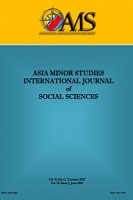Çift Dillilik Bağlamında Suriyeli Mülteci Öğrenciler ve Kilis Ġli Örneği
Syrian Refugee Students in the Context of Bilingualism and the Example of Kilis Province
Author(s): Hüseyin DOĞRAMACIOĞLUSubject(s): Language acquisition, Social Theory, Sociology of Culture, Migration Studies, Turkic languages
Published by: Kilis 7 Aralık Üniversity
Keywords: Bilingualism; Kilis; Syrian refugee students;
Summary/Abstract: Kilis is a frontier city with a history dating back thousands of years and located at the junction of different cultural and demographic structures. This city has a rich cultural structure as it is located at the intersection of various cultures. However, in the last ten years, different cultures and generations have begun to be seen here, as refugees who have escaped from the turmoil in Syria and sought refuge in our country have settled in Kilis. Refugees who immigrated to Kilis and whose mother tongue is mostly Arabic, interacted with Kilis culture when they encountered it. This interaction emerged mostly on the basis of language. After these people settled in Kilis, the children born here were educated at schools as bilingual students who could speak both Turkish and Arabic fluently. While these students were given education in different places at first, they continued to study in the same classes with the Turkish population in recent years. Thus, it was observed that cultural interaction accelerated and bilingual individuals increased. This generation can be characterized as individuals who both know and live the Turkish language and culture, know the Arab civilization and know Arabic very well because it is their mother tongue.
Journal: Asia Minor Studies
- Issue Year: 2022
- Issue No: 2
- Page Range: 207-213
- Page Count: 7
- Language: Turkish

